
By Beverly Goodman, Assistant Professor, Leon Charney School of Marine Sciences - University of Haifa
September 25, 2011
Sediment coring is a job that is one part experience, one part planning, and many parts luck. Before we arrived in the Yucatan the team spent months discussing and planning how we would accomplish our goals to collect a series of sediment cores from target areas underwater around the site. We had to think about the depth of the water, the types of sediments, and the best (and available) equipment. Ultimately, we decided to hedge our bets and come prepared with a variety of options in our toolbox, and see what worked best.
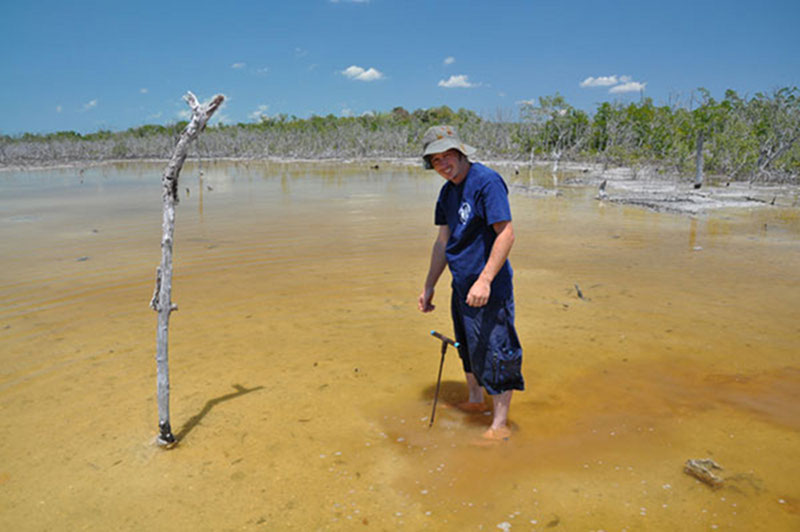
Conducting a preliminary survey of potential coring sites around Vista Alegre, Dan Leonard sinks a metal probe down into the sediments to estimate depth. Image courtesy of Proyecto Costa Escondida Maritime Maya 2011 Expedition, NOAA-OER. Download larger version (jpg, 1.9 MB).
Trish Beddows, the team hydrogeologist, and I met in Chicago to organize some of the equipment before we flew down to meet the rest of the crew in Mexico. Trish brought along a Livingston corer, which is a specially designed device that is useful in lake bottom sediments, which we expected to be similar to what we’d find at Vista Allegra. As a back up, I brought plans for having a hammering device machined locally when we arrived.
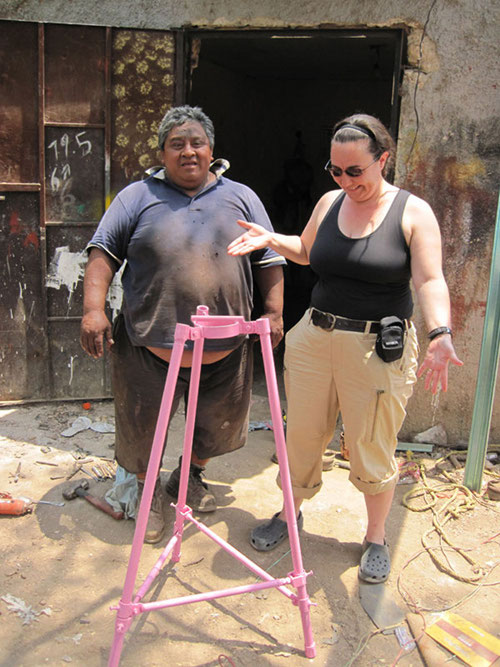
Trish Beddows proudly stands with Freddy Flores, Kantunilkin’s local welder who created coring equipment, including this pink tripod for the project. Image courtesy of Proyecto Costa Escondida Maritime Maya 2011 Expedition, NOAA-OER. Download larger version (jpg, 5.7 MB).
Meanwhile, Dominique, Derek and Dan were at the site already preparing the coring base, which was made by rigging a platform across two small rowboats. They set the stage and went right to work with general site descriptions, mapping, and biological collections. They also toured around the site with a probe to test the depths of the sediments. This information would be important for us to pinpoint areas with the greatest potential for collections.
As soon as we arrived in Mexico, we quickly went out searching for a welder to build our back-up coring equipment. Trish’s fluent Spanish led us to a local expert in metalworking who took on the challenge. In no time we had a device ready in case the Livingstone caused us trouble. He even humored our request to paint it pink!
Getting from the archaeological home base in Kantunilkin to the research site is no simple task. First, we drove to the harbor town of Chiquila. There, we loaded all of our equipment and supplies for 3-4 days of field time at the site onto a boat. The team that was already in Mexico had already taken care of the difficult task of bringing out all the necessities and setting up the field camp (and building the coring raft!). The site is primitive, so no electricity or running water. We loaded up with food, water, ice, field gear, generators, and off we went on a boat from Chiquila.
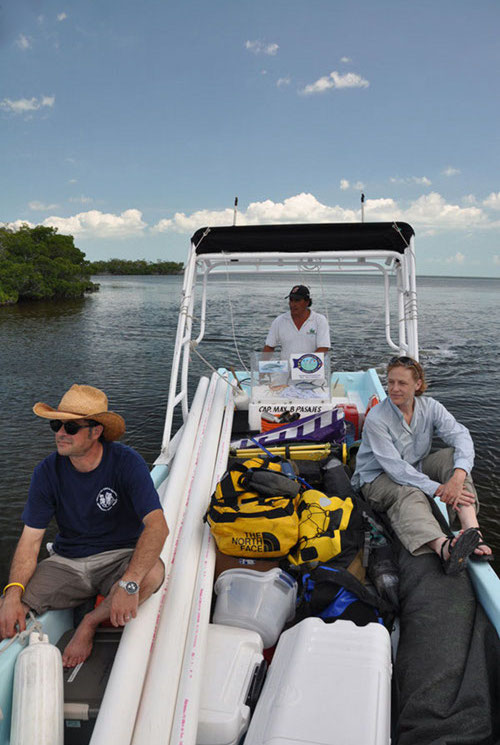
Surrounded by equipment and supplies for several days of field work, Dominique Rissolo and Beverly Goodman arrive at Vista Alegre on one of the local lanchas from Chiquila, captained by Roberto Echevaria. Image courtesy of Proyecto Costa Escondida Maritime Maya 2011 Expedition, NOAA-OER. Download larger version (jpg, 1.8 MB).
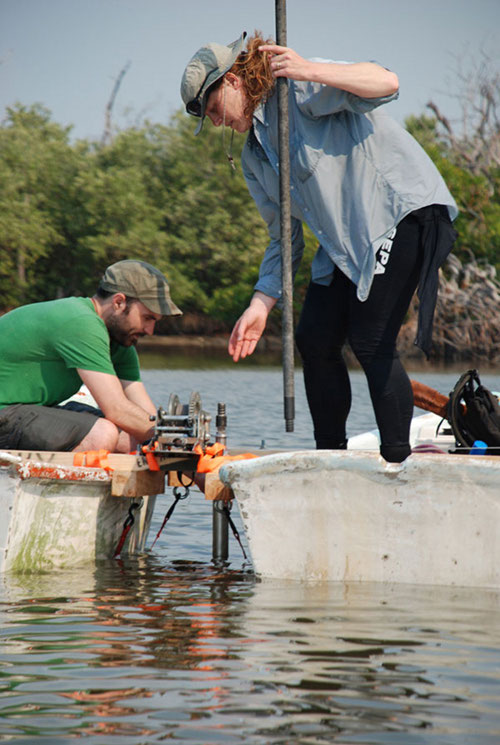
Working on the project’s mobile coring platform, Wes Patterson and Beverly Goodman test out the Livingston Corer in the East Harbor. Image courtesy of Proyecto Costa Escondida Maritime Maya 2011 Expedition, NOAA-OER. Download larger version (jpg, 2.6 MB).
The first day of coring was a day of trial and error. We set up the Livingstone corer on land, and gave it an experimental test. Everything seemed to work as it should. We headed out in our mobile floating coring platform with support canoes to the first targets. We tried the Livingston Corer. Nothing. We tried again. Nothing. We tried again. Nothing. We checked the parts, we changed some techniques. Nothing. This happens in coring sometimes. Technically, the Livingston is perfect for these sediments and this environment. However, practically, it simply didn’t happen. We moved on to the handmade coring device.
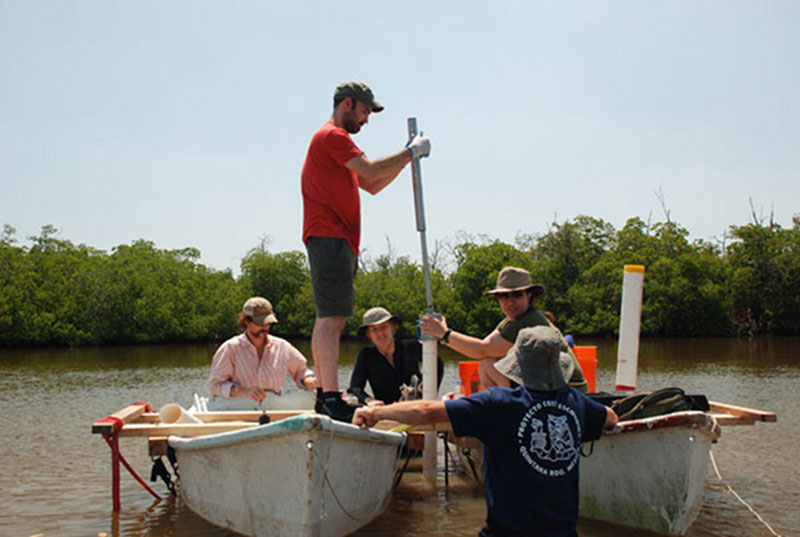
Using PVC piping and a hammering device fabricated by Freddy Flores, the team sinks a core in the West Harbor. Image courtesy of Proyecto Costa Escondida Maritime Maya 2011 Expedition, NOAA-OER. Download larger version (jpg, 2.9 MB).
We chose to use PVC pipes for collection because they are light, easy to cut, widely available, and relatively affordable. Unfortunately, though, they also shatter easily if you hit something hard while coring. During our first test core, the core went in smoothly. Then, we had to get it out. Hammering in and removing are two very different animals. One of our items on the equipment list didn’t make it to the field—the come-along winch. Derek jumped in immediately and suggested we use the tension straps as a substitute. The straps were tossed over the branch, hooked onto the prusik-knot pulling rope and after a bit of patience, VOILA!!! The core began coming out. There was a lot of celebrating….until we saw the crushed bottom of the core—we’d hit something hard and cracked the PVC. It was an important lesson for later cores.
The second day we headed out only with the made-in-Mexico corer. We hoped from site to site and successfully collected a series of cores from 30 cm to 2 meters long. It became clear that it was soon time to open the cores and have an idea of what we should expect.